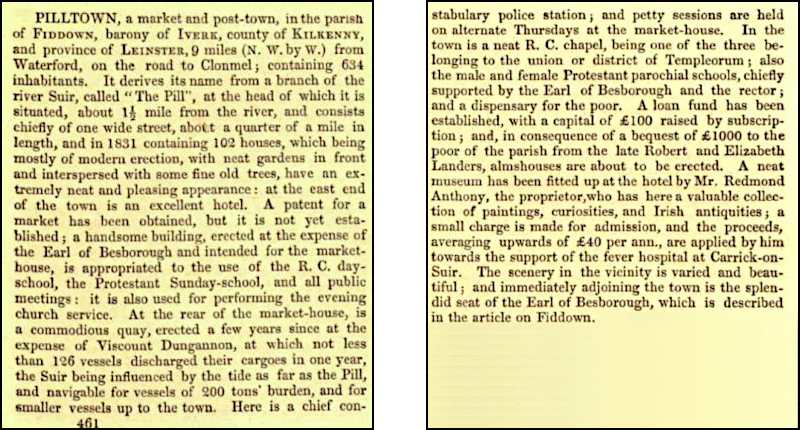Johanna Phelan Family History
Kilkenny Background
Johanna’s grandparents moved into Piltown, Co. Kilkenny, in the 1840s when it was a thriving “Model Village”. The village was built by the Earl of Bessborough in the early 19th century as a model for all landlord estate villages1. Piltown was the largest of his estate villages and adjoined his demesne. Owning (pronounced “Ooning”) was another one. Lewis' Topographical Dictionary[7] describes it as a market and post-town2, 9 miles (Irish miles – equivalent to 11.5 statute miles) from Waterford city, containing 624 inhabitants.

The Lewis Topographical Dictionary entry for Piltown
It was an attractive location in which to set up home.
Piltown is located close to the southern border of Co. Kilkenny, on the old road between Carrick on Suir and Waterford City.
Piltown and its surroundings
The map shows Piltown and the surrounding area. The Bessborough Estate with its grand Georgian house was sold by the ninth Lord Bessborough in the late 1930s. A religious order established a seminary there in 1941, before selling it in 1971 to the Department of Agriculture. Since 1980 the grounds have been the home of Kildalton Agricultural College. Amongst the places which figure later in this story, the townland of Jamestown is located on the L1035 just south of the hairpin bends and Templeorum is located a little further north where the road has a loop.
1 Habitually Estate villages came into existence because a prominent landowner, often newly-arrived in the country, recognised the merits of developing an urban settlement. The advantages were two-fold: providing secure habitation for tenants whose loyalty could be ensured, and creating centres of commercial activity which would generate additional income for the landlord. (From: “Mapped, A Study of Planned Irish Villages”, Dublin School of Architecture, Dublin Institute of Technology 2017.) ↑
2 In the nineteenth century the postal service was based on a network of towns with post offices, where mail was delivered and collected, rather than delivery to individual addresses. Being a post-town was an important commercial status symbol ↑


